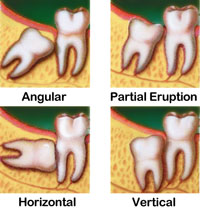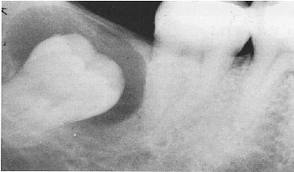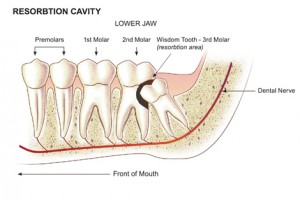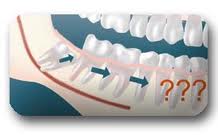Third molars erupt in the mouth when a person reaches the age of 17-21 years, when most individuals become adults, hence the term “wisdom teethâ€. However, not everyone has wisdom teeth, and not having one should not be a case for concern. According to medterm.com, 7.6% of the population does not have wisdom teeth all their life. On the other hand, some appear to not have them, but they are actually embedded within the jaw due to lack of space to erupt. Hence a visit to the dentist is essential to check whether your tooth is missing, or whether there are problems involved in its eruption like impaction and infection. Here are some reasons that indicate you should have your tooth pulled out:
1. Caries on the tooth itself
The wisdom tooth being situated so far back in the mouth, one may find it hard to keep that part of the mouth clean, even missing it entirely during tooth-brushing. Hence dental caries is almost imminent. Early carious lesions may be filled and the tooth retained, but if the caries is extensive and not restorable, the tooth is best extracted. Carrying out procedures such as root canal therapy in an attempt to salvage a wisdom tooth is extremely difficult because of the position in the back of the mouth. The dentist has limited access to that part of the mouth, and the patient can only open his or her mouth to a certain extent.
2. Caries on adjacent tooth and food impaction
More often than not, third molars tend to tilt forward instead of growing upright into the oral cavity. When it hits against the adjacent tooth, its growth is impeded, that is when it becomes an “impacted third molarâ€. Food can easily get trapped in the space between the second and the third molar, and often only the use of dental floss can you be rid of this trapped food. If it is not removed thoroughly, caries may start in the adjacent tooth, next to the trapped food. You may not be able to observe this in your own mouth, and the tooth goes untreated until caries has reached the deeper pulp layer, which compromises the health of the tooth. To prevent this, look out for signs such as a foul-taste in the region of an impacted tooth. Otherwise, a dental check-up would prove useful, whereby your dentist will have an X-ray taken, and any caries will be easily identified.
3. Embedded tooth and cyst formation
As mentioned above, some teeth are embedded within the jaw and will not erupt due to lack of space; hence they are not visible in the mouth. These teeth should be extracted, as un-erupted teeth will lead to cyst formation (known as a dentigerous cyst). Cysts are pathological cavities lined by epithelium and filled with fluid contents.
4. Infection, abscess and cellulitis
Infection in relation to a wisdom tooth may be from food entrapped around the it, or from caries that has spread from the outer enamel layer into the pulp, which then leads to an abscess formation. More serious cases of infection like cellulitis are life-threatening; hence, like in any other cases of infection, the source of infection should immediately be removed; in this case, it is the 3rd molar.
5. Trauma to opposing gums, cheeks, tongue
Sometimes a wisdom tooth that has erupted out of the normal alignment of teeth causes trauma to your opposing gums, cheeks or tongue. Naturally you would want to be rid of such an irritation.
6. Resorption
Wisdom teeth that grow with its crown towards the adjacent tooth may sometimes cause breakdown, or resorption, of the adjacent tooth.
7. Lower anterior crowding  and orthodontics
Due to the fact that wisdom tooth grows out last in the mouth, its growth may cause a slight push of all the teeth in a forward direction. As a result, a previously properly aligned dentition can become crooked, especially in the lower front teeth region. To prevent this, wisdom teeth are extracted when there are signs of crowding. For the same reason, wisdom teeth are extracted in teenagers undergoing orthodontic treatment; otherwise they might interfere with the alignment of the teeth after the orthodontic treatment is complete.
8. Others
It is better to extract a tooth at a younger age for several reasons. As age advances, extracting a tooth becomes a more complex procedure. The elderly has weaker jaw bones, increased health problems such as bleeding problems or hypertension, and less tolerance to a surgical procedure.
That being said, all surgical procedures have their risks, so it is important to seek the advice of a dental officer before you decide to have your tooth extracted.




nice article! Looking forward to ur next one